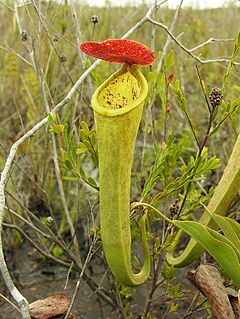Related Research Articles

Welwitschia is a monotypic gymnosperm genus, comprising solely the distinctive Welwitschia mirabilis, endemic to the Namib desert within Namibia and Angola. The plant is commonly known simply as welwitschia in English, but the name tree tumbo is also used. It is called kharos or khurub in Nama, tweeblaarkanniedood in Afrikaans, nyanka in Damara, and onyanga in Herero. Welwitschia is the only living genus of the family Welwitschiaceae and order Welwitschiales in the division Gnetophyta, and is one of three living genera in Gnetophyta, alongside Gnetum and Ephedra. Informal sources commonly refer to the plant as a "living fossil".

Mirabilis is a genus of plants in the family Nyctaginaceae known as the four-o'clocks or umbrellaworts. The best known species may be Mirabilis jalapa, the plant most commonly called four o'clock.

Proteus is a genus of Gram-negative Proteobacteria. Proteus bacilli are widely distributed in nature as saprophytes, being found in decomposing animal matter, sewage, manure soil, the mammalian intestine, and human and animal feces. They are opportunistic pathogens, commonly responsible for urinary and septic infections, often nosocomial.

Annus Mirabilis is a poem written by John Dryden published in 1667. It commemorated 1665–1666, the "year of miracles" of London. Despite the poem's name, the year had been one of great tragedy, including the Great Fire of London. The title was perhaps meant to suggest that the events of the year could have been worse. Dryden wrote the poem while at Charlton in Wiltshire, where he went to escape one of the great events of the year: the Great Plague of London.

Proteus mirabilis is a Gram-negative, facultatively anaerobic, rod-shaped bacterium. It shows swarming motility and urease activity. P. mirabilis causes 90% of all Proteus infections in humans. It is widely distributed in soil and water. Proteus mirabilis can migrate across the surface of solid media or devices using a type of cooperative group motility called swarming. Proteus mirabilis is most frequently associated with infections of the urinary tract, especially in complicated or catheter-associated urinary tract infections.

Mirabilis jalapa, the marvel of Peru or four o'clock flower, is the most commonly grown ornamental species of Mirabilis plant, and is available in a range of colors. Mirabilis in Latin means wonderful and Jalapa is the state capital of Veracruz in México. Mirabilis jalapa was cultivated by the Aztecs for medicinal and ornamental purposes.

Licor 43, or Cuarenta y Tres, is a Spanish liqueur, made in Cartagena, Spain. Also known as Colt 43.

Nepenthes mirabilis, or the common swamp pitcher-plant and tropical pitcher plant, is a carnivorous plant species. By far the most widespread of all Nepenthes, its range covers continental Southeast Asia and all major islands of the Malay Archipelago, stretching from China in the north to Australia in the south. The species exhibits great variability throughout its range. One of the more notable varieties, N. mirabilis var. echinostoma, is endemic to Brunei and Sarawak and possesses an extremely wide peristome.

Nepenthes rowaniae is a species of pitcher plant endemic to the Cape York Peninsula, Australia. It is closely related to N. mirabilis and was once considered an extreme form of this species.

Nepenthes beccariana is a tropical pitcher plant. The species was described in 1908 by John Muirhead Macfarlane based on a specimen collected from the island of Nias, which lies off the western coast of Sumatra. It appears to be closely related to both N. longifolia and N. sumatrana, and the former is possibly a heterotypic synonym of this taxon.

The Ussuri shrew, also known as the giant shrew, is a species of shrew found in Northeast Asia. An adult Ussuri shrew has a total length including the tail of 137 to 170 mm. It is found in valleys and on the forested slopes of mountains in the Korean Peninsula, northeastern China, and the Russian Far East. It is rarely observed, and its ecology is largely unknown.

Nepenthes tenax is a lowland species of tropical pitcher plant native to northern Queensland, Australia. It is the third Nepenthes species recorded from the continent and its second endemic species. Nepenthes tenax is closely related to the three other Australian Nepenthes species: N. mirabilis, N. rowaniae and N. parvula.
Nepenthes × mirabilata is a natural hybrid involving N. alata and N. mirabilis.

The white-throated jay, also known as the Omiltemi jay, is a species of bird in the family Corvidae. It is endemic to the Sierra Madre del Sur ranges of Mexico.

Woutersia was a Triassic genus of 'symmetrodont' and the only representative of the family Woutersiidae. It was originally classified as a kuehneotheriid, but it has been suggested that it may be related to Docodonta. Remains of W. mirabilis and W. butleri have been found in the Gres à Avicula contorta Formation at Saint-Nicolas-de-Port, France, while W. mirabilis has been found in Varangéville, France; remains have been dated to the Late Triassic, 205.6 to 201.6 Ma.
The Syncystidae are a family of parasitic alveolates in the phylum Apicomplexa. Species in this family infect insects (Aeshnidae).
Tigranella is a genus of longhorn beetles of the subfamily Lamiinae, containing the following species:

Bohemiclavulus is a genus of synapsids that was discovered in the Slaný Formation in the Czech Republic. It is only known from a single spinous process fragment.
References
- ↑ BioLib.cz - Tigranella mirabilis. Retrieved on 8 September 2014.